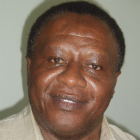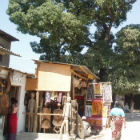By: George Achia
Send to a friend
The details you provide on this page will not be used to send unsolicited email, and will not be sold to a 3rd party. See privacy policy.
Tanzanian government funding aims to help weavers, wood carvers and furniture makers profit from science, says George Achia.
In Mwenge, a district in northern Dar es Salaam, Tanzania, there is a market where ebony sculptures, wood carvings and other craftworks are sold.
The market is a major tourist attraction in the city.
On stall number 25 stands a huge wood carving of people holding one another.
This piece was made by Deo Kafwa, a veteran woodcarver who has been in the trade for more than twenty years.
Business backing
The hardwood carving illustrates Tanzania's policy of 'Ujamaa na kujitegemea' — or socialism and self-reliance — introduced by the country's first president, Julius Nyerere.
It is so skilfully crafted that potential buyers stand admiring the work for a long time.
One German tourist appears fascinated with the artwork. The tourist finally buys the carving for US$5,000. This is how much such works can cost, depending on their style, design and creator.
This wood-carving market benefitted when the government gave four groups of firms a start-up fund of 32 million Tanzanian shillings (around US$19,000) through the Tanzania Commission for Science and Technology (COSTECH), to enable them to expand their business initiatives using science and technology.
As well as the woodworking cluster, the funding went to an ICT (information communication technology) cluster, a furniture-making cluster and a handloom cluster.
Each cluster is made up of firms within the same geographical area, and was set up with the aim of establishing links between them to improve their collective competitiveness.
According to Hassan Mshinda, the director-general of COSTECH, the initiative is a way of getting people in the clusters to think about how they can increase their performance using research and the latest technology.

Hassan Mshinda is the director-general of COSTECH
Credit: David DIckson
"Science, technology and innovation are key for any private sector to have competitiveness," he tells SciDev.Net.
"Today we talk about IKEA — the Swedish company that designs and sells furniture — as one of the best suppliers of furniture in the world. This is because it knows which timber is good for which product, treatment and design, and the best technology to use [in furniture construction]."
Mshinda adds that clusters provide an excellent environment for innovation to thrive through interaction and learning.
For Tanzania to fast-track its economic growth, he says, already established clusters should be helped to access and benefit from science, technology and innovation.
"As a body charged with advising the government on all matters that relate to science, research and development, we want to see science playing a bigger role in socioeconomic development," says Mshinda.
Promoting science
The woodcarving cluster plans to use the money in three ways: to pay designers to come up with new products to sell; to set up a revolving fund offering loans than are repaid and then loaned again to finance the cluster's operation; and to provide loans to members to pay for their professional development at both an individual and group level.
"Cluster members are firms, and in order to build their competitiveness, we facilitate and promote the use of science, technology and innovation," explains Mshinda, adding that the money given to the clusters is intended to enable them to access and adopt new technologies.
For example, to encourage members to be more innovative, the woodcarving cluster is to hold a four-day trade fair, supported through the revolving fund, that will involve key stakeholders, including academics, private sector representatives not engaged in wood carving, and government representatives.
During the fair, there will be a competition with an award for the most innovative product.
"The competitiveness of the wood cluster members is not only about products but also the quality, branding and so on," says Kafwa, who as well as being a carver is the coordinator of the wood carving cluster. "We in the wood cluster need to produce products that will compete in the global market with carvings from other countries, like Kenya."
According to Kafwa, the lack of specialised training centres and art schools to help carvers enhance their skills is a major challenge.
He says that, although the government "has stepped in late" to provide support, he welcomes its backing.
Building links
Before receiving funding from COSTECH, the members of each cluster were trained by the commission on how to develop a business plan setting out how they intend to improve their competitiveness in global markets through innovation.
Cluster initiatives work through facilitators selected by cluster members. Kafwa says that all cluster facilitators are trained to help their initiatives develop.
"In most cases, the leadership involves academia, the private sector and government representatives. These people are the bridge to cluster members. For example, if there is an issue that needs government intervention, then the leader from government will link it up," he explains.
Omar Bakari, the coordinator of COSTECH's cluster development programme, tells SciDev.Net that many governments and industry organisations across the globe have turned to the concept of clusters in recent years to stimulate urban and regional economic growth.
He says that the commission is using this approach to link entrepreneurs with government organisations and academics.

The Mengwe Carvers Market in Dar-es-Salaam, Tanzania
Credit:David Dickson
According to him, this approach allows different people, including those from the private sector, to develop a greater appreciation of the value of science, technology and innovation in fostering economic growth.
Turning to another of the groups of firms being supported, Bakari notes that "the furniture cluster needs to produce products that will compete with Chinese products".
So far, he says, this cluster produces school desks, chairs, office furniture and couches. "But we need them to produce the best not only for local use, but also for export," he explains.
This, Bakari says, is possible when furniture cluster members know what type of timber is most suited to which product, and what is the best technology to use.
Sustainable wood
He adds that some tree species, such as teak mahogany, are now becoming scarce in Tanzania because of environmental degradation and overexploitation for wood carving and furniture making.
For instance, Bakari says that both the woodcarving and furniture making clusters should explore working with university departments of forestry to find alternative woods that can be harvested sustainably. He says the two clusters should explore working with the University of Dar es Salaam and its faculty of forestry.
COSTECH's cluster development initiative begun as part of a project funded by the Swedish International Development Cooperation Agency in African countries including Kenya, Nigeria and Uganda.
The latest support is the second round of funding COSTECH has released as part of the initiative. Last year, it disbursed 40 million Tanzanian shillings (more than US$24,000) to five cluster groups on the island of Zanzibar.
The project will end this year, but the Tanzanian government through COSTECH has already integrated the initiative into a government programme with a start-up fund of 300 million Tanzanian shillings (around US$184,000).
George Achia currently holds an IDRC/SciDev.Net science journalism internship award.
This article has been produced by SciDev.Net's Sub-Saharan Africa desk.


